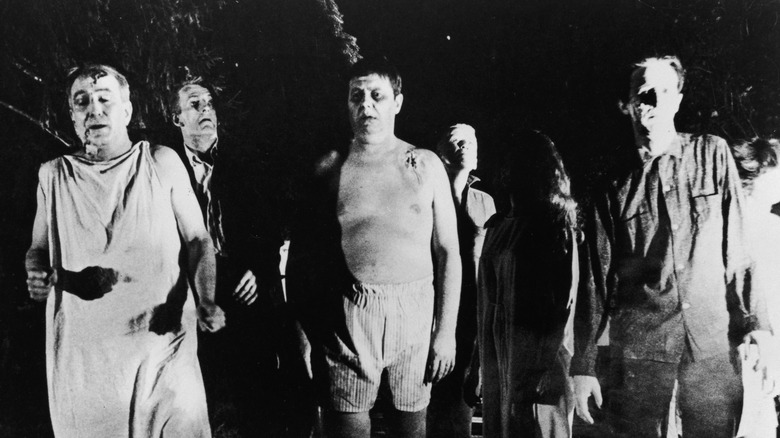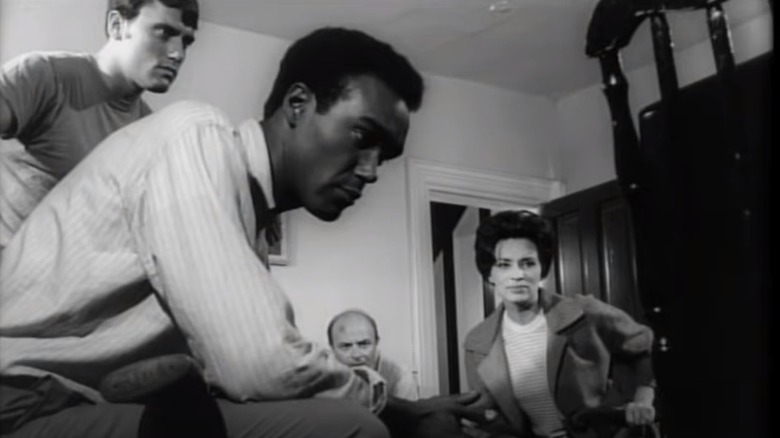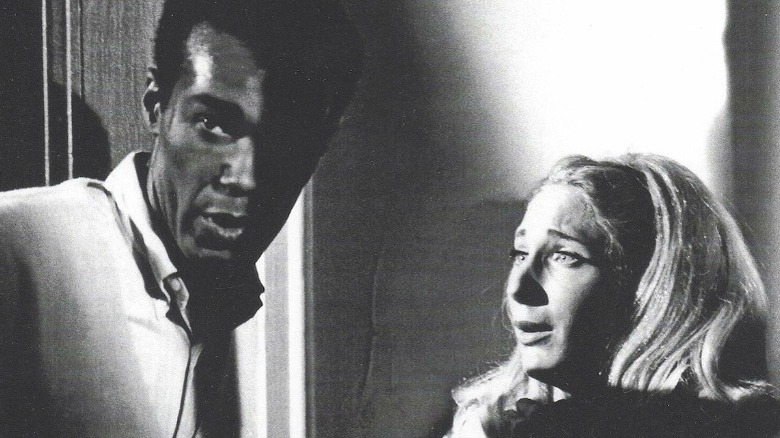How George Romero Cobbled Together A Cast For Night Of The Living Dead
Even in death, it seems that George Romero still has some tricks up his sleeve. We should expect nothing less from the father of the modern zombie movie. The filmmaker made his directorial debut in 1968 with the seminal zombie film, "Night of the Living Dead." The movie would spawn a six-film zombie franchise for Romero ending in 2009 with "Survival of the Dead." In addition to the zombie franchise, the horror icon also directed "The Crazies," "Creepshow," and "The Dark Half."
But Romero's work on "Night of the Living Dead" will forever be his magnum opus. The movie follows seven people trapped in a rural farmhouse as the dead come back to life with a hunger for flesh. Modern critiques and analysis of "Night of the Living Dead" contend that the film is an allegory for race relations in late 1960s America. But as Romero admitted in an in-depth interview, revealed posthumously (very zombie-like, George), much of the film's meaning may have been unintentional. He was too busy trying to find enough people to act in the movie.
He started shooting before the script was done
After George Romero died in 2017, Variety published a previously unreleased interview from 1972 in which the director detailed how he made "Night of the Living Dead." The conversation revealed some surprising facts about the film. The movie was shot in Pittsburgh, where Romero worked as a TV commercial producer. He co-wrote the screenplay with John Russo, and they began shooting before the script was even finished, furiously writing as they filmed.
Because Pittsburgh is a far cry from Hollywood, assembling a cast proved difficult. Although the film has been lauded for its commentary on race relations, Romeo admits that any message was unintentional. He cast former English professor and theater director Duane Jones as the film's protagonist, Ben. It was the first time an African American had been cast as the lead in a horror film. On the casting of Jones, Romero said:
"We had no preconceived notion as to the role being a Black role, Duane came in, he looked right, he read well, so we used him. We never took any further note of it. It's not mentioned in the script at all..."
The rest of the cast was rounded out by random Pittsburgh residents. For the often-histrionic Barbra, Romero cast Judith O'Dea, a Pittsburgh native who was living on the West Coast at the time. Judy was played by Judith Ridley, a local secretary, and Tom was played by Ridley's boyfriend, Keith Wayne. The Coopers, played by Karl Hardman and Marilyn Eastman, were two investors in Romero's film company, and Hardman's daughter, Kyra Schon played the Cooper girl, Karen. And what about those zombies? He enticed friends and clients with the promise of food, beer, and a good time.
Romero did have one specific actress in mind for the role of Barbra, but he was refused by a friendly neighbor.
Romero wanted a Mister Rogers' Neighborhood actor
One would think that zombies and children's television shows don't mix, but before zombie flicks, Romero directed a short film for Fred Rogers' program "Mister Rogers' Neighborhood." According to CTV, Romero wanted Betty Aberlin, who played Lady Aberlin on "Mister Rogers' Neighborhood," to play Barbra. Although Fred Rogers was a fan of the movie, he refused the filmmaker's request. Romero recalled:
"He wouldn't allow that. I originally wanted to use her in the role of Barbra and Fred put his foot down and said no."
Romero instead turned to 23-year-old Judith O'Dea. According to the L.A. Times, the Pittsburgh native had been acting in stage and local productions since the age of 15, and had just recently moved to Hollywood to pursue movies when Romero began casting for "Night of the Living Dead." Producer Russell Streiner (who also played Barbra's brother Johnny) remembered O'Dea from their time together at a drama school and asked her to come back to Pittsburgh to audition.
A few legitimate actors in Duane Jones and O'Dea and a ragtag group of producers, investors, and friends is what Romero had to work with. In describing the independent production, Streiner said, "It was a real 'You-bring-the-scenery; I'll-bring-the-costumes' movie." The result was a film all of Pittsburgh could be proud of. The blood and guts were provided by a local butcher shop, friends helped with the special effects, O'Dea's father even played a member of the zombie-hunting posse. Romero called in every favor he possibly could to maximize his $114,000 budget. Like a zombie, the film refuses to die. Despite its controversial release, it lives on as a cult classic and was selected in 1999 for preservation in the National Film Registry by the Library of Congress.


